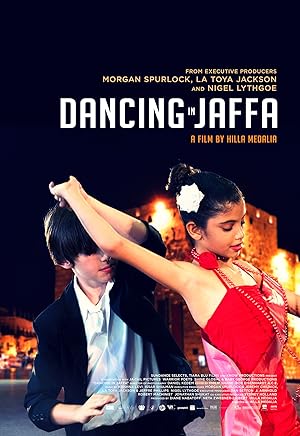I may roll my eyes at many tropes, but I am a sucker for the inspirational teacher that changes students’ lives trope. Throw in some dancing, and I will definitely watch it. I saw Take the Lead, a drama starring Antonio Banderas, and Mad Hot Ballroom, a documentary, but I did not realize that both movies share the same origin story: Pierre Dulaine’s Dancing Classrooms, a Social and Emotional developmental program for the New York City Department of Education. Indeed if you asked me who Pierre Dulaine was, despite seeing Take the Lead and Mad Hot Ballroom, I would probably not know before watching Dancing in Jaffa. Dancing in Jaffa is a documentary about Dulaine taking his program to Jaffa in 2011 to create world peace through ballroom dancing in Israel starting with Israeli and Palestinian students who live in Jaffa, his hometown, which he left in 1948 (he was born in 1945).
Dulaine, who has the optimism of a child, but is actually around 67 years old at the time of filming, faces the threat of violence, heartache or broken spirits, but seems hopefully oblivious. It is completely human and natural to want to visit your childhood home, and a camera crew follows him everywhere. In Jaffa, his actions are viewed as a legal threat because he could try to make a legal claim on his home, which he expressly says that he does not want to do. The homeowner communicates to the filmmaker that the homeowner will shoot Dulaine, and the film crew if they continue to stand in the street. Dulaine is an elegant older gentleman, a veteran ballroom dancer and kids and adults can’t figure out if he is Palestinian or Israeli by looking at him. If he is seen as a threat, the region has more endemic problems than even Dulaine expected.
Dancing in Jaffa makes the challenges seem insurmountable. For example, some Muslim children explain that they cannot touch the opposite sex, which will make ballroom dancing impossible. Dancing in Jaffa also shows the nuance of prejudice faced by Palestinian students in progressive spaces such as a mixed school. Teachers and students judge one mourning little girl named Noor as hostile. Noor admits that she hits kids who bully her, but claims that when she reports the bullying to teachers, her complaints are ignored. Every boy avoids dancing with her, and she remains on the edges of all activities. Dulaine and his dance partner show her a little kindness, and by the end of Dancing in Jaffa, Noor transforms. Initially other students complain that she isn’t as good a dancer as the others, but Dulaine still shines favor on her and the quieter students.
Dulaine promises that all the children will transform, and he makes good on his promise. Initially they can barely stand together without loud ridicule over boys and girls mixing together, a natural reaction from kids that age, but by the end of Dancing in Jaffa, they march in organized fashion and are serious about dancing. Without students like Lois, an Israeli who eagerly befriends and socializes with her fellow Palestinian students, Dulaine’s success may not be as obvious. Will Dulaine’s success last when they become adults? The historical, language, cultural and travel barriers are still there, but only time will tell whether Dulaine’s childlike faith in dance is warranted.
Dancing in Jaffa is a must see documentary for people who love the inspirational teacher trope, ballroom dancing or are interested in peace in the Middle East.
Stay In The Know
Join my mailing list to get updates about recent reviews, upcoming speaking engagements, and film news.




